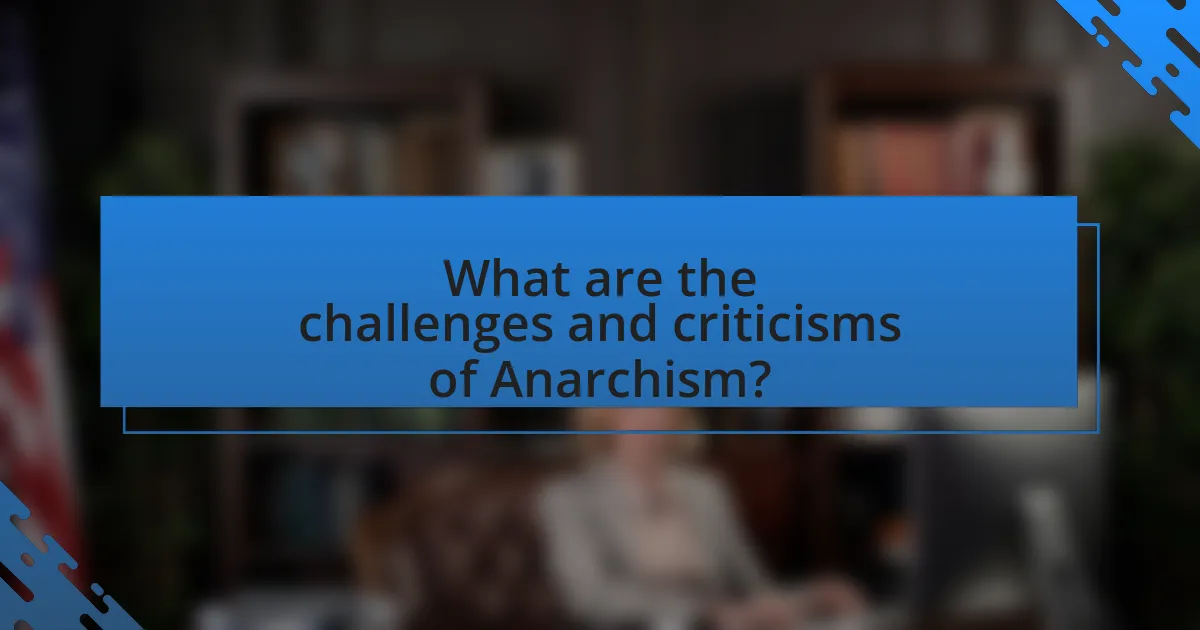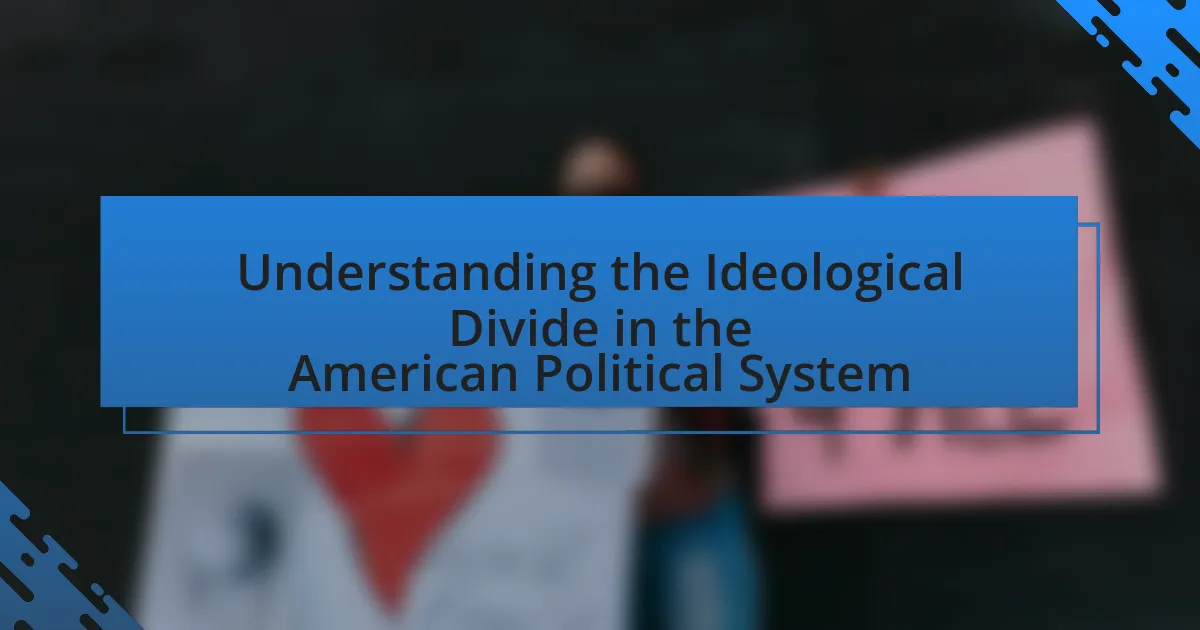Anarchism is a political philosophy advocating for a society organized without hierarchical authority or government, emphasizing voluntary cooperation and mutual aid. Originating in the 19th century, key figures such as Pierre-Joseph Proudhon and Mikhail Bakunin shaped its core principles, which include anti-authoritarianism and self-governance. The article explores the historical context of anarchism, its key figures, core principles, misconceptions, and the practical applications of anarchist thought in society. It also addresses criticisms of anarchism, potential pitfalls, and how individuals can engage with and support anarchist movements.

What is Anarchism?
Anarchism is a political philosophy that advocates for a society organized without hierarchical authority or government. It emphasizes voluntary cooperation, mutual aid, and the belief that individuals can self-govern without coercive structures. Historically, anarchism has roots in the 19th century, with figures like Pierre-Joseph Proudhon, who famously declared that “property is theft,” and Mikhail Bakunin, who argued against state power. Anarchism has influenced various social movements and ideologies, promoting the idea that freedom and equality can be achieved through decentralized, non-hierarchical forms of organization.
How did Anarchism originate?
Anarchism originated in the 19th century as a political philosophy advocating for a society without hierarchical authority or government. The term “anarchism” was first used by Pierre-Joseph Proudhon in 1840, who argued against the state and capitalism, promoting mutualism and voluntary cooperation. Influential figures such as Mikhail Bakunin and Emma Goldman further developed anarchist theory, emphasizing the importance of individual freedom and collective organization. The historical context of industrialization and class struggle during this period significantly shaped anarchist thought, as activists sought to address social inequalities and promote direct action against oppressive systems.
What historical events influenced the development of Anarchism?
The development of Anarchism was significantly influenced by the French Revolution of 1789, which challenged established authority and inspired radical political thought. This event catalyzed the questioning of hierarchical structures and the legitimacy of state power, leading thinkers like Pierre-Joseph Proudhon to articulate ideas of mutualism and anti-authoritarianism. Additionally, the rise of industrial capitalism in the 19th century, marked by social inequalities and labor exploitation, prompted figures such as Mikhail Bakunin and Emma Goldman to advocate for a stateless society and workers’ self-management. The Russian Revolution of 1917 further shaped Anarchist thought, as it presented both opportunities and challenges for anarchists, highlighting the tensions between revolutionary movements and state power. These historical events collectively laid the groundwork for Anarchism as a distinct political philosophy, emphasizing individual freedom and opposition to coercive institutions.
Who are the key figures in the history of Anarchism?
Key figures in the history of Anarchism include Pierre-Joseph Proudhon, Mikhail Bakunin, and Emma Goldman. Pierre-Joseph Proudhon is often regarded as the first anarchist thinker, famously declaring that “property is theft” in his 1840 work “What is Property?” Mikhail Bakunin, a prominent figure in the 19th century, emphasized the importance of collective action and was a key player in the First International. Emma Goldman, active in the early 20th century, advocated for individual freedom and women’s rights, contributing significantly to anarchist thought through her writings and speeches. These individuals have shaped the principles and practices of anarchism throughout its history.
What are the core principles of Anarchism?
The core principles of Anarchism include anti-authoritarianism, voluntary association, mutual aid, and self-governance. Anti-authoritarianism rejects hierarchical structures and coercive institutions, advocating for a society organized without centralized power. Voluntary association emphasizes the importance of individuals freely choosing to collaborate and form communities based on mutual interests. Mutual aid promotes cooperation and support among individuals, fostering a sense of solidarity. Self-governance encourages individuals to manage their own affairs without external control, reflecting the belief in personal autonomy and collective decision-making. These principles are foundational to various anarchist theories and practices, as seen in historical movements like the Spanish Revolution of 1936, where anarchist collectives operated on these ideals.
How does Anarchism define authority and power?
Anarchism defines authority as a coercive force that undermines individual freedom and autonomy. In this framework, power is viewed critically, particularly when it is centralized and hierarchical, as it often leads to oppression and inequality. Anarchists advocate for decentralized forms of organization, emphasizing voluntary cooperation and mutual aid as alternatives to traditional authority structures. Historical examples, such as the Spanish Revolution of 1936, illustrate anarchist principles in practice, where communities organized themselves without centralized authority, demonstrating the feasibility of anarchist ideals.
What role does individual freedom play in Anarchist thought?
Individual freedom is central to Anarchist thought, as it emphasizes the importance of autonomy and self-governance without hierarchical authority. Anarchists argue that true freedom can only be achieved when individuals are liberated from oppressive structures, such as the state and capitalism, which they view as coercive and restrictive. Historical figures like Mikhail Bakunin and Emma Goldman have articulated that individual freedom is not merely the absence of restraint but involves the ability to pursue one’s own interests and desires in a cooperative society. This perspective is supported by the belief that when individuals are free, they can engage in voluntary associations that foster mutual aid and solidarity, leading to a more equitable and just society.
What are common misconceptions about Anarchism?
Common misconceptions about Anarchism include the belief that it advocates for chaos and violence. In reality, Anarchism seeks to establish a society without hierarchical authority, emphasizing voluntary cooperation and mutual aid. Another misconception is that Anarchists oppose all forms of organization; however, many Anarchists support decentralized, non-hierarchical forms of organization that promote collective decision-making. Additionally, some people mistakenly equate Anarchism with criminality, ignoring that many Anarchists advocate for social justice and equality, often participating in peaceful protests and community-building efforts. Historical examples, such as the Anarchist movements during the Spanish Civil War, demonstrate that Anarchism can lead to organized, cooperative societies rather than disorder.
Why do people associate Anarchism with chaos and violence?
People associate Anarchism with chaos and violence primarily due to historical events and media portrayals that emphasize disorder and conflict. Anarchism, which advocates for a stateless society and the abolition of hierarchical structures, has often been linked to violent uprisings and riots, such as the Haymarket Affair in 1886 and various revolutionary movements in the 20th century. These instances have contributed to a perception that Anarchism inherently leads to chaos. Additionally, sensationalist media coverage frequently highlights violent actions by individuals or groups identifying as anarchists, reinforcing the stereotype. This combination of historical context and media representation shapes the public’s understanding of Anarchism as synonymous with chaos and violence.
How does Anarchism differ from other political ideologies?
Anarchism fundamentally differs from other political ideologies by advocating for a stateless society where individuals govern themselves without hierarchical authority. Unlike ideologies such as socialism or liberalism, which may support some form of government or centralized control, anarchism rejects all forms of imposed authority, emphasizing voluntary cooperation and mutual aid among individuals. Historical examples, such as the anarchist movements during the Spanish Civil War, illustrate the practical application of these principles, showcasing communities organized without traditional state structures. This distinct focus on dismantling power hierarchies sets anarchism apart from other political frameworks that often seek to reform or utilize state mechanisms for social change.

How does Anarchism manifest in society?
Anarchism manifests in society through the establishment of decentralized, non-hierarchical structures that prioritize voluntary cooperation and mutual aid. This can be observed in various forms, such as worker cooperatives, community assemblies, and grassroots movements that challenge state authority and promote self-governance. Historical examples include the Spanish Revolution of 1936, where anarchist principles were implemented in Catalonia, leading to the creation of collectivized farms and factories, demonstrating the practical application of anarchist theory in a real-world context. Additionally, contemporary movements like Occupy Wall Street and various anti-globalization protests reflect anarchist ideals by advocating for direct democracy and opposing systemic inequalities.
What are the different types of Anarchism?
Anarchism encompasses various ideologies, primarily including anarcho-communism, anarcho-syndicalism, individualist anarchism, and mutualism. Anarcho-communism advocates for a stateless society where resources are shared communally, as seen in historical examples like the Spanish Revolution. Anarcho-syndicalism emphasizes direct action and workers’ self-management, with the Industrial Workers of the World being a notable organization. Individualist anarchism focuses on personal autonomy and freedom, with thinkers like Max Stirner influencing this perspective. Mutualism promotes a society where individuals exchange goods and services based on mutual consent, drawing from the ideas of Pierre-Joseph Proudhon. Each type reflects distinct principles and historical contexts within the broader anarchist movement.
What distinguishes Anarcho-Communism from Anarcho-Capitalism?
Anarcho-Communism and Anarcho-Capitalism are distinguished primarily by their views on property and economic organization. Anarcho-Communism advocates for the abolition of private property and the establishment of a communal ownership system, where resources are shared collectively to ensure equality and meet everyone’s needs. In contrast, Anarcho-Capitalism supports the idea of private property and free markets, emphasizing individual ownership and voluntary exchanges as the basis for economic interactions. This fundamental difference in property rights and economic structure reflects their divergent goals: Anarcho-Communism seeks to eliminate class distinctions and promote egalitarianism, while Anarcho-Capitalism aims to maximize individual freedom and personal wealth through market mechanisms.
How do various Anarchist movements operate in practice?
Various Anarchist movements operate through decentralized, non-hierarchical structures that emphasize direct action and mutual aid. These movements often organize themselves into affinity groups or collectives, where decision-making is achieved through consensus rather than top-down authority. For example, during the Spanish Civil War, anarchists established collectives that managed agriculture and industry cooperatively, demonstrating practical applications of anarchist principles. Additionally, contemporary movements like Occupy Wall Street utilized horizontal organizing to facilitate discussions and actions without centralized leadership, showcasing the effectiveness of anarchist practices in mobilizing communities.
What role does community play in Anarchist philosophy?
Community plays a central role in Anarchist philosophy as it emphasizes mutual aid, cooperation, and decentralized decision-making. Anarchists advocate for the formation of voluntary associations and communities that operate without hierarchical structures, promoting self-governance and collective responsibility. Historical examples, such as the Spanish Revolution (1936-1939), illustrate how anarchist communities successfully organized themselves through federations, prioritizing communal needs over individualism. This focus on community fosters social bonds and empowers individuals to participate actively in shaping their environments, aligning with the anarchist principle of autonomy.
How do Anarchists organize without centralized authority?
Anarchists organize without centralized authority through decentralized networks and voluntary associations. These structures rely on direct democracy, consensus decision-making, and mutual aid, allowing individuals to collaborate based on shared interests and goals. Historical examples include the Spanish Revolution of 1936, where anarchist collectives effectively managed agriculture and industry without hierarchical control, demonstrating the feasibility of such organization. Additionally, contemporary anarchist movements often utilize online platforms for coordination and communication, further facilitating decentralized collaboration.
What examples exist of successful Anarchist communities?
Successful anarchist communities include the Zapatista communities in Chiapas, Mexico, and the anarchist territories during the Spanish Civil War, particularly in Catalonia. The Zapatistas have established a self-governing system that emphasizes autonomy, collective decision-making, and sustainable agriculture since the 1994 uprising. In Catalonia, during the Spanish Civil War (1936-1939), anarchists organized a large-scale collectivization of industries and agriculture, leading to significant improvements in workers’ rights and living conditions. These examples demonstrate the viability of anarchist principles in practice, showcasing effective self-management and community resilience.

What are the challenges and criticisms of Anarchism?
Anarchism faces several challenges and criticisms, primarily centered around its perceived impracticality and potential for chaos. Critics argue that without a centralized authority, social order may deteriorate, leading to violence and instability, as evidenced by historical instances such as the Spanish Civil War, where anarchist factions struggled to maintain cohesion against centralized forces. Additionally, opponents claim that anarchism lacks a clear framework for governance and economic organization, which can result in inefficiency and conflict over resources. Furthermore, some critics assert that anarchism may inadvertently empower local tyrannies or warlords in the absence of a state, undermining the very freedoms it seeks to promote. These criticisms highlight significant concerns regarding the feasibility of anarchist principles in practice.
What are the main criticisms of Anarchist theory?
The main criticisms of Anarchist theory include its perceived impracticality, the potential for chaos, and the difficulty in achieving consensus among diverse groups. Critics argue that without a centralized authority, societal order may break down, leading to disorder and violence. Historical examples, such as the Spanish Civil War, illustrate challenges faced by anarchist movements in maintaining stability and unity. Additionally, opponents contend that anarchism lacks a clear framework for governance, which raises concerns about how essential services and infrastructure would be managed effectively.
How do critics argue against the feasibility of Anarchism?
Critics argue against the feasibility of Anarchism by asserting that it lacks a practical framework for governance and social order. They contend that without a centralized authority, there is a risk of chaos and conflict, as seen in historical examples like the Spanish Civil War, where anarchist principles led to fragmentation and infighting among various factions. Additionally, critics highlight the challenge of resource distribution and public services in an anarchist society, pointing to the necessity of organized systems to manage complex societal needs effectively. Furthermore, they argue that human nature, characterized by competition and self-interest, makes it unlikely for a purely voluntary society to function harmoniously without some form of regulation or authority.
What are the potential pitfalls of Anarchist practices?
The potential pitfalls of Anarchist practices include the risk of fragmentation and lack of cohesion among groups, which can lead to ineffective action and internal conflict. Anarchism often emphasizes individual autonomy and decentralized decision-making, which, while promoting freedom, can result in disorganization and difficulty in achieving collective goals. Historical examples, such as the Spanish Civil War, illustrate how anarchist factions struggled to unify against a common enemy, ultimately weakening their position. Additionally, the absence of a structured leadership can create power vacuums, allowing for the emergence of authoritarian figures or groups that contradict anarchist principles.
How do Anarchists respond to these criticisms?
Anarchists respond to criticisms by emphasizing their commitment to voluntary cooperation and the dismantling of coercive structures. They argue that many criticisms stem from misunderstandings of anarchist principles, particularly the belief that anarchism equates to chaos or disorder. Anarchists assert that their vision promotes a society based on mutual aid, non-hierarchy, and self-governance, which can lead to more equitable and just social arrangements. They often cite historical examples, such as the Spanish Revolution, where anarchist principles were successfully implemented, demonstrating that organized, non-hierarchical societies can function effectively.
What arguments do Anarchists present to defend their ideology?
Anarchists defend their ideology primarily by arguing that hierarchical structures, such as the state, inherently lead to oppression and inequality. They assert that a society without centralized authority can foster voluntary cooperation and mutual aid, promoting individual freedom and social justice. Historical examples, such as the Spanish Revolution of 1936, illustrate successful anarchist practices where communities self-organized without state intervention, demonstrating the viability of anarchist principles in real-world scenarios. Additionally, anarchists emphasize the importance of personal autonomy and the belief that individuals can govern themselves without coercive institutions, which they argue leads to a more equitable and just society.
How do Anarchists envision a functioning society without government?
Anarchists envision a functioning society without government through decentralized, voluntary associations and mutual aid. They propose that communities can self-organize based on principles of cooperation, direct democracy, and non-hierarchy, allowing individuals to collaborate freely without coercive authority. Historical examples, such as the Spanish Revolution of 1936, demonstrate successful anarchist practices where workers managed industries and communities collectively, emphasizing the feasibility of such systems. Anarchists argue that human beings are capable of self-governance and can create social structures that prioritize individual freedom and collective responsibility, as evidenced by various anarchist experiments throughout history.
What practical steps can individuals take to engage with Anarchism?
Individuals can engage with Anarchism by educating themselves on its principles, participating in local anarchist groups, and advocating for decentralized decision-making in their communities. Education can involve reading foundational texts by authors like Peter Kropotkin and Emma Goldman, which provide insight into anarchist theory and practice. Joining local anarchist collectives or attending events fosters community engagement and collaboration on mutual aid projects. Additionally, individuals can promote anarchist ideals by supporting grassroots organizations that emphasize self-governance and direct democracy, thereby contributing to the practical application of anarchist principles in everyday life.
How can one learn more about Anarchist principles and practices?
To learn more about Anarchist principles and practices, one can read foundational texts by key theorists such as Peter Kropotkin, Emma Goldman, and Mikhail Bakunin. These authors provide insights into the philosophy and practical applications of anarchism, emphasizing mutual aid, voluntary cooperation, and anti-authoritarianism. Additionally, engaging with contemporary anarchist literature and participating in local anarchist groups or discussions can deepen understanding. Academic courses on political theory or social movements often include modules on anarchism, providing structured learning opportunities.
What actions can individuals take to support Anarchist movements?
Individuals can support Anarchist movements by actively participating in grassroots organizing, promoting mutual aid initiatives, and engaging in direct action. Grassroots organizing involves joining or forming local collectives that align with anarchist principles, fostering community solidarity and collective decision-making. Promoting mutual aid initiatives, such as food distribution or community resource sharing, exemplifies the anarchist value of cooperation without reliance on state structures. Engaging in direct action, which can include protests, strikes, or other forms of civil disobedience, helps to challenge oppressive systems and raise awareness about anarchist ideals. Historical examples, such as the Spanish Civil War, demonstrate the effectiveness of these actions in mobilizing communities and creating alternative social structures.





